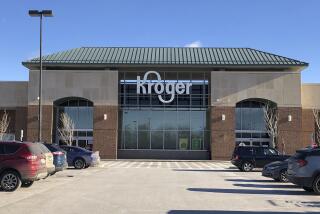Price Club Parent Plans Stepped-Up Expansion Effort
SAN DIEGO — About the only knock against Price Co. in recent years was that the successful operator of 67 Price Club discount membership warehouses wasn’t expanding the chain fast enough.
Taking the criticism to heart, it has embarked on an aggressive growth plan. The San Diego-based chain will add about 12 locations this year and a similar number in coming years, Chairman Robert Price said in an interview. The chain is particularly targeting new sites in the Northeast.
Analysts credit the expansion plan for a surge in Price Co. stock in recent weeks. The shares closed at $55.75 in over-the-counter trading Monday after having traded as low as $26.50 the past year.
Although widely considered the inventor of the discount warehouse concept, Price Co. has been lagging the industry’s expansion. Last year, its revenue advanced 8% to $5.4 billion, while industrywide revenue grew 25% to $21.1 billion. Price opened only five locations in 1990. That compares to 24 new stores last year for Sam’s Wholesale Club, based in Bentonville, Ark., and 11 for Costco Wholesale of Kirkland, Wash., Price’s two main competitors.
Sam’s, in fact, overtook Price as the industry’s revenue leader in 1990, with $6.4 billion in sales, compared to Price’s $5.4 billion.
Founded by retail wizard Sol Price in 1976, Price is still the industry bellwether. Despite a host of imitators in addition to Sam’s and Costco, Price leads in average annual sales per location--$115 million per site, about 60% more than its closest rival.
Sol Price, who turned over the chairmanship to his son Robert in 1989, invented the membership warehouse concept. It is a combination of discount merchandising and a selective membership policy designed to limit credit risks. Membership is open only to certain government employee groups, credit union members and business licensees.
Sol Price also developed Price Club’s merchandising approach--an assortment of goods ranging from Levi’s, fur coats and meats to soap, Rolex watches and Alfa Romeo automobiles. The huge warehouses stock only 3,000 items, one-tenth those of a typical department store.
But the concept has become more popular than even Price envisioned, so the company is playing catch-up to establish itself in new markets. Arthur Markowitz, an editor with Discount Store News, an industry trade magazine based in New York, said Price’s accelerated expansion plan is a response to an imperative to stake its claim in “under-warehoused” markets, particularly areas of the Northeast.
“There’s a lot of room. You’re talking about a 12-state region with only 49 stores at the end of last year. California alone has 74 stores,” Markowitz said.
But there is a sense among some analysts that Price blew an opportunity to dominate some areas, as it has Southern California, with its 20 locations.
Bo Cheadle, managing director and retail analyst with Montgomery Securities in San Francisco, singles out the San Francisco Bay market dominated by Costco. He says Price recognizes the “strategic error” it made by failing to give competitors the respect they deserved.
“Price executives may have developed a superiority complex that it didn’t make any difference if a competitor went into a given market ahead of it because there was such a wide disparity between how good Price was and how bad everyone else was,” Cheadle said. “So there was no rush to lock up cities or markets on the part of Price Club.”
Price’s go-slow expansion policy also hurt its “same-store sales” growth rate. A key measure of a retailer’s health, same-store sales track growth at warehouses open a year or more.
Many Price Clubs have reached maximum volume levels. So a small number of new-location openings creates a smaller base on which the company can build sales.
Price is taking the expansion and competition seriously, Cheadle said, as evidenced by the $250 million in bonds it sold earlier this year to finance expansion and development of real estate adjoining existing Price Clubs.
In an interview last week, Price conceded that the chain may have lost an opportunity or two but disputes the contention that, with more aggressive expansion, it could have kept other competitors from starting up.
Price said his reluctance to expand rapidly was based partly on Price philosophy of close hands-on management and on the company’s insistence that it buy instead of lease all its sites.
Price also admitted to not being sure that the Price Club concept would fly in other parts of the nation as well it does in Southern California. “There was the perception here that the East Coast and the buyers there were different and that we weren’t in touch with what would sell there,” he said.
THE GROWTH OF DISCOUNT CHAINS Growth of the largest discount warehouse chains in revenue and locations.
Name and Headquarters 1990 Sales 1989 Sales Sam’s Wholesale $6.44 billion $4.84 billion Club (1), Bentonville, Ark. Price Club (2) $5.41 billion $5.01 billion San Diego Costco Wholesale $4.059 billion $2.943 billion Kirkland, Wash. Pace Membership (3) $2.295 billion $1.7 billion Aurora, Colo. BJ’s Wholesale (4) $1.150 billion $985 million Natick, Mass. Price Savers (5) $865 million $685 million Salt Lake City Wholesale Club (6) $726 million $570 million Indianapolis Warehouse Club $265 million $267 million Skokie, Ill. Wholesale Depot (7) $50 million** $10 million** Natick, Mass.
Name and Percent Stores Open Headquarters Change 1/90 1/91 12/91* Sam’s Wholesale 33.1% 123 147 200 Club (1), Bentonville, Ark. Price Club (2) 8% 53 66 78 San Diego Costco Wholesale 37.9% 58 69 79 Kirkland, Wash. Pace Membership (3) 35% 47 78 94 Aurora, Colo. BJ’s Wholesale (4) 16.8% 23 27 35 Natick, Mass. Price Savers (5) 26.3% 14 -- -- Salt Lake City Wholesale Club (6) 27.4% 23 28 NA Indianapolis Warehouse Club unch. 12 10 10 Skokie, Ill. Wholesale Depot (7) 400% 2 3 6 Natick, Mass.
* projected ** estimate; company is privately held and not required to divulge earnings
Notes: (1) Sam’s is a subsidary of Wal-Mart Stores. (2) Price Co.’s 1990 revenues reflect 100% ownership of 10 Canadian locations as of 12/90; the company had previously owned 50%. (3) Pace Membership is a subsidary of K mart. (4) BJ’s is a subsidiary of Waban Inc. (5) Price Savers was acquired by Pace in December, 1990 (6) Wholesale Club was acquired by Sam’s in February, 1991
Source: Discount Store News, company reports. Sales figures are for company’s fiscal year.
More to Read
Inside the business of entertainment
The Wide Shot brings you news, analysis and insights on everything from streaming wars to production — and what it all means for the future.
You may occasionally receive promotional content from the Los Angeles Times.










